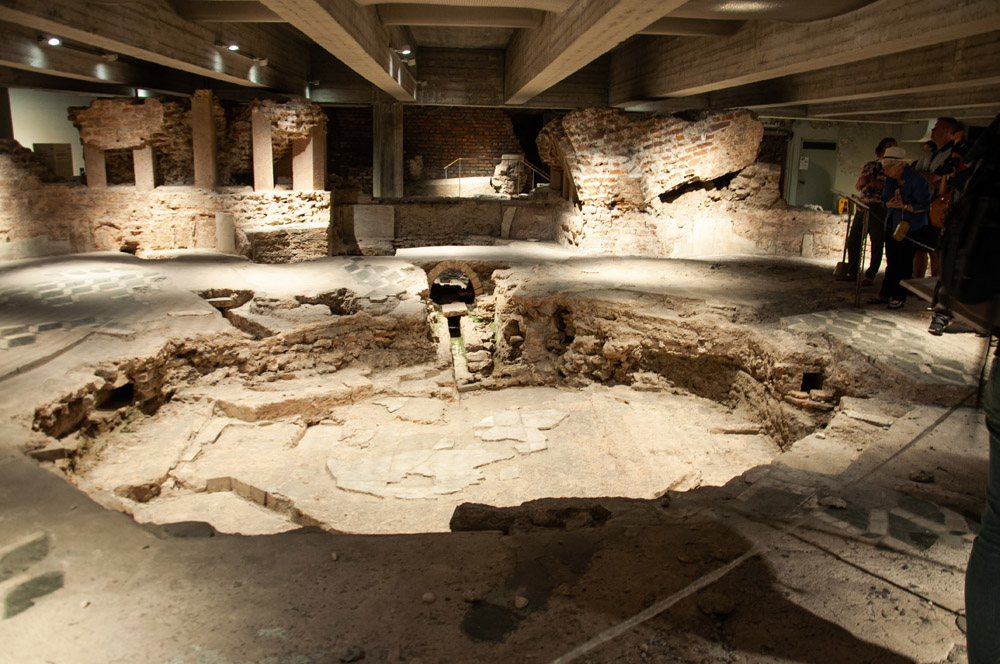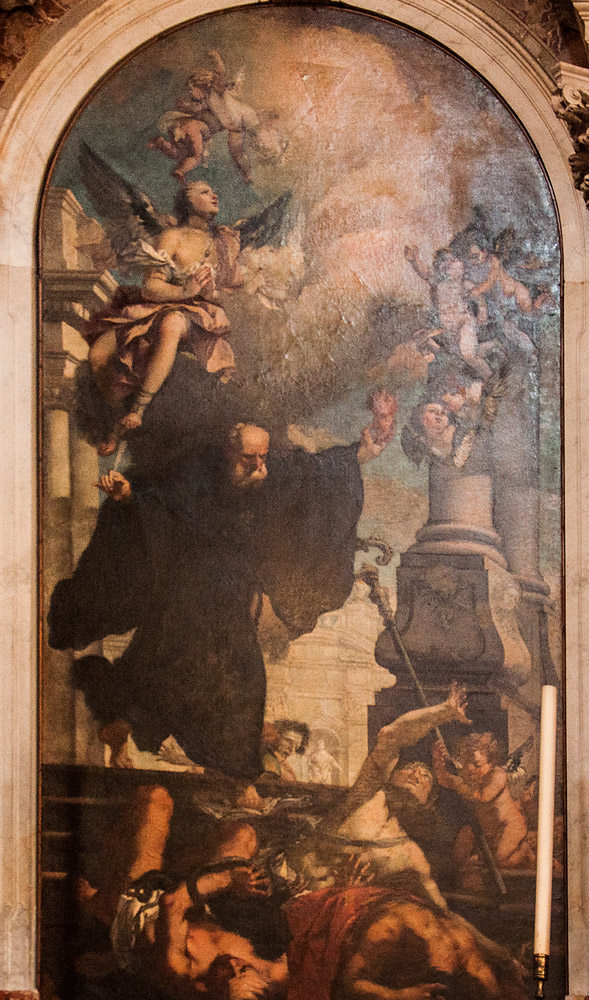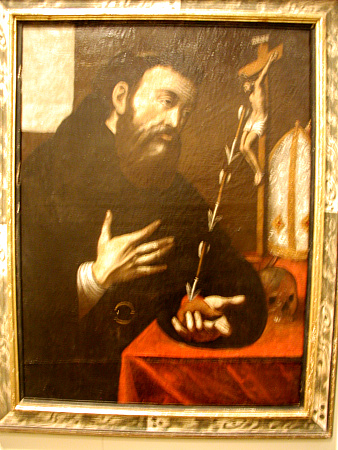Such splendor is not based on the practice of the historical Augustine. The Golden Legend quotes him as having disdained costly garments and even selling them off when they arrived as donations so that their "price may be shared by all." Rather, the image of Augustine in rich vestments is drawn from the liturgy and the legends, and is meant to envision the saint as he is now, in Heaven.
In the liturgy, the splendid garment appears in the Collect for the saint's feast on August 28: "In the midst of the Church he opened his mouth, and God filled it with the spirit of wisdom and intellect; he clothed him in a robe of glory" (Missale Romanum, 529).
Building on the idea of the "robe of glory," the hagiography collected in the Golden Legend tells of three miracles in which the saint comes from Heaven "splendid in his pontificals" to encourage those who have prayed to him – in one case arriving on "a shining cloud."1 "Pontificals" are the beautiful garments worn by a medieval bishop on especially important occasions.
A religious order known as the Eremitical Augustinians had a large number of churches and friaries across Europe. Their rule was based on the writings of St. Augustine, and images created for them often pictured Augustine in the black habit of the order, sometimes replacing the pontificals (as in the second picture at right) and sometimes underneath them (as in this example). The habit included a belt modeled on one that the Augustinians believed had been given by the Virgin Mary to St. Monica.2 The Virgin's gift is celebrated in this painting, and the belt is sometimes seen in Augustine's portraits, such as the third picture at right.
ATTRIBUTES
The pontificals, especially the embroidered images on the edging of the cope, are sometimes the only clues to Augustine's identity in an image. But he is often also shown holding a heart, in some cases topped by a flame (example) and in others pierced by an arrow (as in the third picture at right). Molanus (338-39) explains the heart attribute as a reference to two passages from the saint's writings. The first is from a commentary on Proverbs 23:26, "My son, give me thy heart and let thy eyes keep my ways." Augustine writes, "He says, give me. Give me what? Son, your heart. When it stays with you, it will go ill. You will be drawn to toys and to lascivious and harmful loves. Give me, he says, your heart. Let it be mine, and it will not perish."
The second relevant passage, from Confessions IX, 2:3, explains why some images show the heart pierced by an arrow: "Thou hadst pierced [sagittaveras] our heart with thy love, and we carried thy words, as it were, thrust through our vitals." The word translated "pierced" is sagittaveras, literally "shot arrows into." The arrows are pictured in this painting by Filippo Lippi.
AUGUSTINE AND HERESY
In the second picture at right, the flaming heart is pictured as a weapon the saint uses, along with his pen, to drive heresy from the Church. It is true that his writings constituted a successful defense of Catholic Christianity against the alternatives on offer in his time, none of which survived much past his lifetime. But his defense of the faith did not arise as a subject in the art until the period of the Enlightenment. As in the Menescardi at right, Rottmayr's St. Augustine Confuting the Heretics depicts a pile of half-naked heretics lying on the ground before the triumphant writer. Similarly, in Lazzarini's St. Augustine Trampling Heresy he places his foot on yet another supine and half-naked victim.
NARRATIVE IMAGES
The dramatic story of Augustine's conversion and life was well known in the Middle Ages and frequently illustrated. After what he considered a misspent youth he was baptized by St. Ambrose in Milan in 387.

The Church of St. Augustine in San Gimignano has a remarkable cycle of frescoes by Benozzo Gozzoli that traces the saint's life, including the Tolle Lege and the baptism. Elsewhere, topics covered include Augustine's return to Africa, his career as a priest and bishop, his work as a writer and teacher, his authorship of the "Rule of St. Augustine" and even his first day of school.
Another popular subject is the "Parable of the Trinity" (example) According to this legend, Augustine was walking by the seaside meditating on the Trinity when he noticed a boy using a spoon to transfer water from the sea into a little hole in the sand. The boy explained that he intended to move the entire sea into the hole. "What?" said Augustine, "it is impossible!" To this the boy replied that it would be easier to put the entire sea into that hole than it would be to put "the mystery of the Trinity and his divinity into thy little understanding." And then he vanished.5
The miracles effected after St. Augustine's intercession are represented only infrequently. One puzzling case is a painting in which the saint washes the feet of a pilgrim who appears to be Christ himself. Neither Caxton nor the full text of the Legend nor the many pages on Augustine in the Acta Sanctorum have anything to say about such an episode, although in one miracle a group of pilgrims suffering disease is cured by praying at the saint's tomb.
Prepared in 2014 by Richard Stracke, Emeritus Professor of English, Augusta University, revised 2015-08-19, 2018-08-19, 2019-02-19.

St. Augustine in his lavish "pontificals." The other figure is St. Jerome, with his lion and cardinal's attire. Late medieval images often put the two saints together. (See the description page.)

Menescardi's St. Augustine Turns out the Heretics pictures him in the black habit of the Eremitical Augustinians. (See the description page.)

Spain, 17th century. Augustine's heart is pierced by a dart or arrow. (See the description page.)
ATTRIBUTES
- Mitre, Crozier, Cope with decorative hem
- A heart, sometimes flaming, sometimes pierced by an arrow
MORE IMAGES
- Second half of 14th century: Serafini's Allegory of St. Augustine as Master of the Order
- 1426: Augustine is paired with St. Jerome in these panels of the Pisa Polyptych.
- 1473: St. Augustine is the central figure in a Vivarini triptych.
- 1488: Presenting his eponym, the Doge Agostino Barbarigo, in Bellini's Barbarigo Altarpiece.
- Late 15th century: St. Augustine is pictured without any specific attributes in this painting of the Four Doctors of the Church.
- 1513-14: A very unusual portrait of Augustine in the habit of the Eremitani Augustinians of Ferrara.
- 1702: Statue of St. Augustine holding a flaming heart.
- 1753: In the margin of a Mexican nun's badge.
- 19th century: In Sebastiano Santi's Crucifixion with Saints Saints Augustine and other saints contemplate Christ on the cross.
DATES
- Feast day: August 28
- Lived 354-430
BIOGRAPHY
- Golden Legend #124: html or pdf
- Acta Sanctorum, August vol. 6, 213-460
- Augustine's vita in The Roman Breviary: English translation, III, 862-63; Latin original, 1012-1013
- Catalogus Sanctorum, VII, fol. 149.
ALSO SEE
NOTES
1 Ryan 129, 131. The Latin phrase is insignitus pontificalibus (Graesse 562, 563), which Ryan translates "arrayed in pontifical vestments." But the meaning of insignitus is more like "distinguished, striking, remarkable, notable" (Lewis s.v. insignitus).
2 Catholic Encyclopedia, s.v. "Confraternities of the Cord."
3 The Carpaccio, from 1511, is in One Hundred Saints, 124. I also found it on 2021-12-03 at this page on Wikimedia Commons.
3 Butler, 426-34.
4 Quotations taken from Caxton, who says he found the story "painted on an altar of St. Austin at the black friars at Antwerp" but not from any of his written sources, "neither in English, French, ne in Latin." Also see Duchet-Suchaux, page 51 for the story and page 52 for the bibliography.